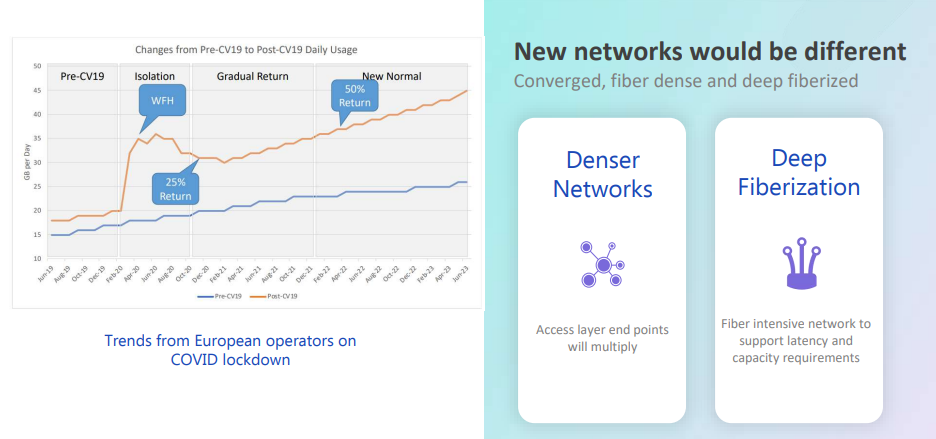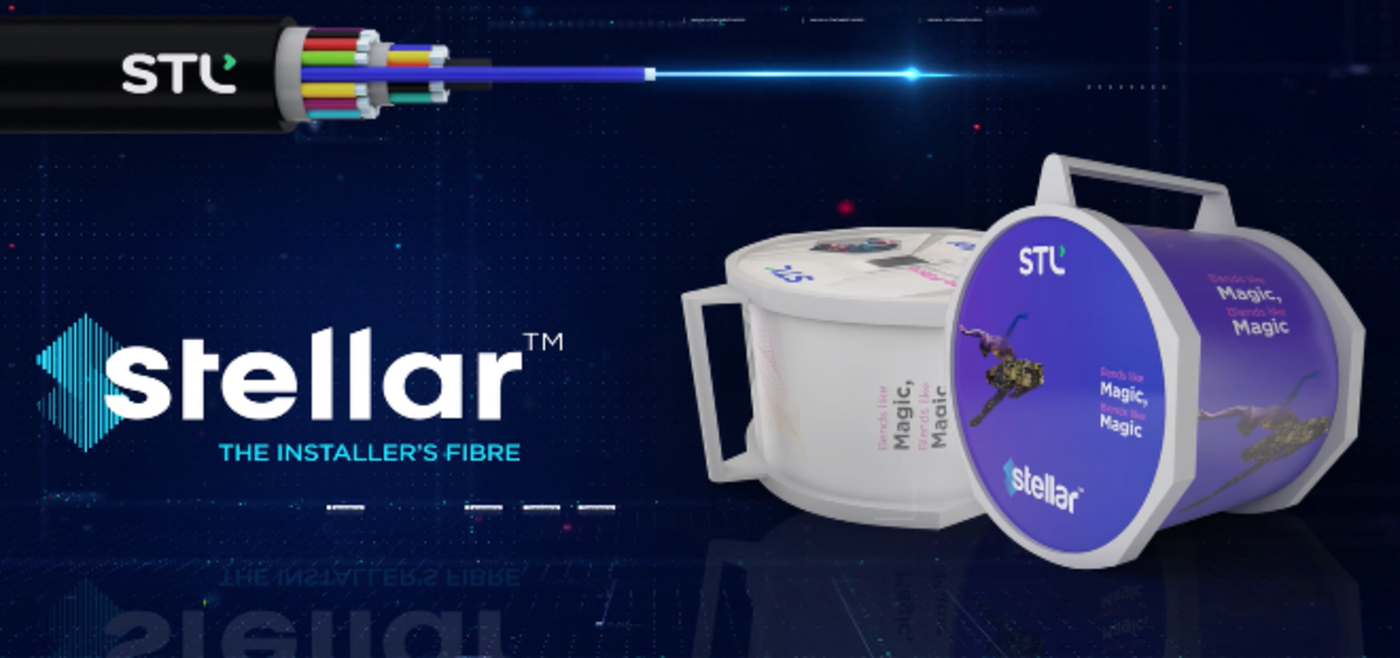
In the world of optic fibre, we are witnessing a significant shift from G652A.D to G657.A1 as the primary transmission fibre due to its superior bend performance. As the fibre deployment rate has exponentially increased, the next critical step is the broader deployment of G657.A2, a better class of bend-insensitive optic fibres. The shift to bend-insensitive fibre deployment, either fully or partially, will bring network installation, performance, and maintenance benefits, especially with the A2 class, as it is backwards compatible with G652.D, the legacy fibre. In this discussion, we shall get a better understanding of the following key topics,
- A brief background about bend-insensitive fibre standards
- Examples of highly bend-insensitive fiber deployment in a broader sense in networking and the benefits it brings along with it
- A2 bend-insensitive fibre compatibility with legacy and actives
Contents
- 1 Covid-19 lockdown accelerated use-case adoption
- 2 Optic fibre evolution
- 3 New Networks- Benefits
- 4 Networks are susceptible to optical losses
- 5 Macro-bend Loss Prevalent in Passive Ancillaries
- 6 Macro-bend prevalent in passive ancillaries- Access networks
- 7 Factors leading to macro bend losses
- 8 Data transmission interruption with Legacy fibre due to accidental bend
- 9 A bend-insensitive fibre solves the challenge
- 10 Reduced operational expense with bend-insensitive fibre
- 11 The challenge still remains
- 12 Conclusion
Covid-19 lockdown accelerated use-case adoption
Covid-19 lockdown had created a significant surge in daily data consumption. It was due to the fact people were isolated with not much to do in terms of physical movement and travelling. Most employees across the world used the work from home option, and conferences were held virtually, thereby consuming more data than in pre-covid times. The use of social media, OTT, online shopping, video calling, etc., has increased multifold, driving data networks into overdrive. Even post-covid, the data usage has not slowed down since WFH has become the new normal and will continue to do so even in the future. To manage such huge data transfer needs for both upstream and downstream ends, there is a need for a converged, fibre dense, and deeply fiberized network. This is where bend-insensitive fibres will come into the picture and slowly replace legacy fibres.

Optic fibre evolution
Optical fibres have evolved over decades both in terms of backward compatibility and bend performance. ITU (International Telecommunication Union) standards assess the quality standards and offer recommendations for network fibres. G.652.D has been the gold standard single-mode fibre widely installed across the world. Although they are very efficient in carrying a large amount of data, their bend performance has become an obstacle leading to the development of new and improved optic fibres that are bend-insensitive, which has now led to the development of G.657.A2 bend-insensitive fibres.
The ITU standards have focused on bend performance, but maintaining backward compatibility is an industry imperative that cannot be sacrificed for bend optimization. There are various STL fibres developed from OH-LITE to BOW-LITE SUPER which have different backward compatibility and bend optimization. Has STL developed a fibre that is both backward compatible and bend-insensitive that can successfully replace legacy fibre in networking? At the end of this discussion, you will get an answer.
New Networks- Benefits
Incorporating A2 bend-insensitive fibre into the new networks has the potential to solve a lot of challenges and improve network performance, reduce costs, and faster deployment.
- Enhanced network performance: The new solutions will improve network performance for a longer period of time.
- Reduced network ownership costs: The new solutions will reduce network costs and operational expenses.
- Faster network provisioning: The new solutions enable faster deployment, thus increasing the speed of customer onboarding.
Networks are susceptible to optical losses
Although completely eliminating optical losses is next to impossible, reducing them is still crucial in order to maintain network performance for a long time. There are many optical fiber losses like absorption loss, scattering loss, and radiation loss, but the most prominent loss that affects network performance is macro bend loss. Especially, legacy fibre G.652.D is highly susceptible to macro bend losses, especially over long routes. As there is increased geographical spread, there is more bend and turns in the network path leading to increased macro bend loss at higher wavelengths. The GPON, C-Band, 10G-PON, 40G-PON, and L-Band networks all experience macro bend loss to different extents when legacy fibre G.652.D is used.

Macro-bend Loss Prevalent in Passive Ancillaries

Macro bend loss is prevalent in long-distance routes with 1.06dB loss per macro-bend point with legacy G.652.D fibre @ 1625nm.
Macro-bend prevalent in passive ancillaries- Access networks
When tests were conducted for 16 routes for access networks with legacy G.652.D fibre, 6 out of these networks experienced data losses greater than 0.5dB due to macro bends at JB’s, tapping boxes, etc.
Factors leading to macro bend losses
Usually, the legacy G.652.D fibre optic networks like FTTH run long distances in km and are divided into feeder networks, distribution networks, and last mile. Various macro bend losses occur at these network junctions. The reasons for such bending losses include,
- Feeder network
- Joint Splicing
- Fibre Attenuation
- Fibre Cuts
- Connector loss
- Accidental bends
- Distribution
network
- Splitter loss
- Connector loss
- Splice loss
- Accidental bend
- Last
Mile (Inside Building)
- HTB connector loss
- Bend loss
- Staple loss
- Accidental Bend during O&M
Data transmission interruption with Legacy fibre due to accidental bend

A bend-insensitive fibre solves the challenge
Suppose you replace legacy G.652.D fibre with G657.A2 bend-insensitive fibre, then macro bend losses can be reduced significantly as these fibres have the resilience to accidental bends due to cuts and repairs, and deskilled installation allows faster deployment.

Reduced operational expense with bend-insensitive fibre
If we manage to replace legacy fibre with bend-insensitive fibre, then we can expect reduced operational costs and increase the network life by 10+ years. In addition, the lower macro bend loss increases resilience and eliminates frequent maintenance and repairs.

Legacy fibre-based cables are not ideal for faster network densification; the end-to-end joint splicing process takes a longer time.

In comparison, bend-insensitive fibre cable enables faster network provisioning as there is a 40% reduction in installation.

The challenge still remains
Although bend-insensitive fibre offers superior performance, MFD mismatch at the connector interface between legacy fibre and bend-insensitive fibre is still a concern. As a result, the network can experience data loss at these junctions, and measurement is also tricky.


Conclusion
To hit two birds with one stone, STL has developed a Stellar bend-insensitive fibre that has the best-in-class attenuation and bends insensitivity solving both backward compatibility and bending losses. This right balance makes Stellar the future of fibre networks suitable for multiple applications.
















